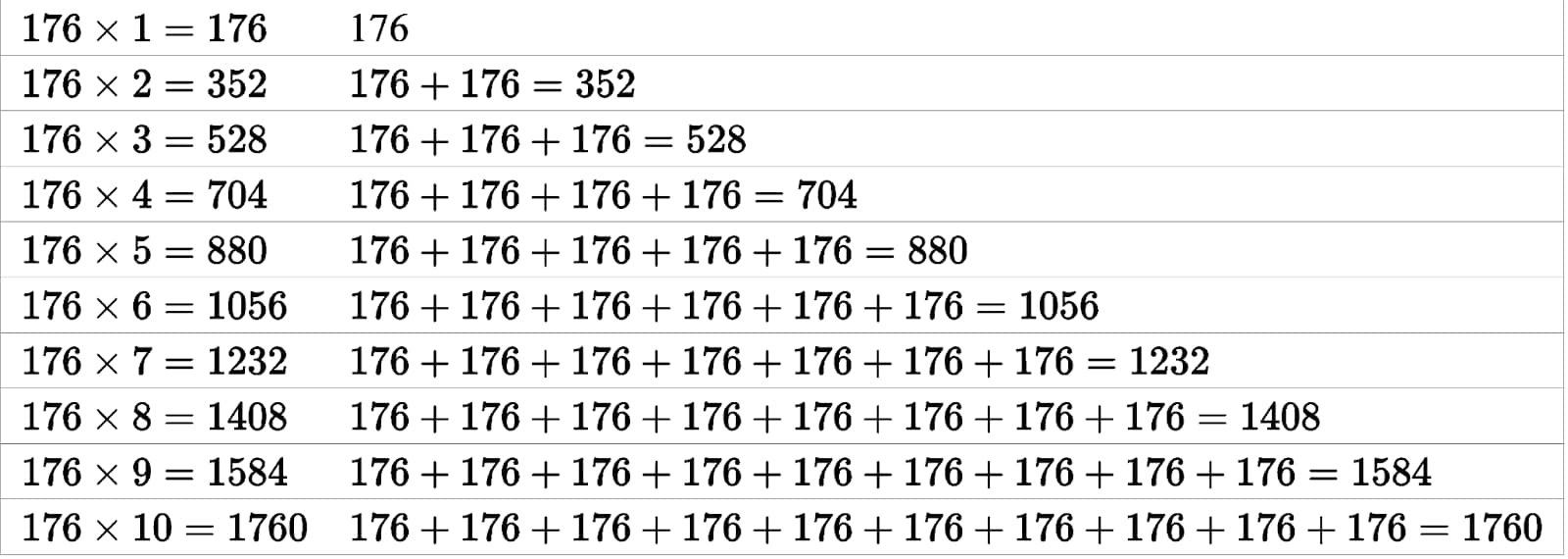Table of 176
Introduction
The multiplication table of a number is the repeated addition of the number to itself for a given number of times. So three times 176 is a shorthand for 176+176+176. So, in other words, it can be said that a multiplication table is the list of the multiples of a number. A multiplication table is a basic mathematical operation that is taught to students at an early age. These tables are extremely useful for doing mathematical operations on numbers.
Description of Multiplication Table Chart
A multiplication table chart is a list of multiples of a given number. A multiplication table can be obtained by multiplying the number with whole numbers from one to ten. This chart is helpful in arithmetic operations. These are the building blocks for working on maths like fractions, exponents and many more.
How to Read The Multiplication Table Chart?
A multiplication chart is a table that presents the products of two whole numbers. One column of numbers is written on the left side, and another set is on the right side. In between those two, a sign(X) of Multiplication is written. Then a column on the right side is written, which is the multiplication result of the numbers present on its left-hand side.
Easy Tips for Multiplication
Below are a few tips that have to be kept in mind for making multiplication easy and fast.
1-Multiplication of any number with 0 will be 0.
2-Multiplication of any numbers with 1 will be the number itself.
3-Multiplication of a number with 10 will be a number with 0 at its unit place. For example, if we multiply 9 by 10, the result is 90.
4-Take any number between 1 to 9, and multiply It by 11. The result will be the duplication of the number. For example, multiply 4 by 11, and the result is 44.
5-The multiplication of a number by 2 is the double of the number. Similarly, the multiplication of a number by 4, is two times the double of the number. For example, if we multiply 5 by 4, then the result will be 20, as we first doubled 5, resulting in 10, and then we doubled it again, resulting in 20. So the final outcome is number 20.
Easy Steps to Teach Multiplication
Step one: Start with the physical manipulatives
The Countable manipulatives turn multiplication into a hands-on concept. Any small tokens will work here(buttons, blobs of modelling clay)
To make it easier to grasp, kindly use the following strategies here
A-Objects should be grouped into sets
B-Use an array
Step two: Introduce skip counting method
Once they get the hang of arranging the manipulatives and counting them out, ease the students into skip counting.
Arrays or sets are still helpful here. Once they know each row contains a given number of units, they should start adding them together to reach an answer.
Step three: highlighting Commutative Property to the students
The multiplication's commutative property is the property to reverse a sum and still get the same result. That’s why 2 x 8 and 8 x 2 both equal 16.
If the student understands the commutative property, he will be able to handle multiplications much more easily. Students will also be able to memorise their tables more easily because learning one multiply means you also learn its reverse multiply.
Solved Examples:
Example 1- Multiply 24 and 12
Solution: 24 \times 12=288
![]()
Example 2- Multiply 10 and 8
Solution: 10 \times 8=10+10+10+10+10+10+10+10=80
![]()
Example 3- Multiply 100 with 10
Solution: 100 \times 10=1000
![]()
Example 4: Is 2 a factor of 176?
Solution: 2 is a factor of 176, so Yes.
Example 5: Multiply a third of 6 by 176.
Solution: 6 times 176= 1056
One-third of 1056 = \frac{1}{3}\times 1056=352 ![]()
Multiplication Table of 176
\begin{array}{|ll|}
\hline 176 \times 1=176 & 176 \\
\hline 176 \times 2=352 & 176+176=352 \\
\hline 176 \times 3=528 & 176+176+176=528 \\
\hline 176 \times 4=704 & 176+176+176+176=704 \\
\hline 176 \times 5=880 & 176+176+176+176+176=880 \\
\hline 176 \times 6=1056 & 176+176+176+176+176+176=1056 \\
\hline 176 \times 7=1232 & 176+176+176+176+176+176+176=1232 \\
\hline 176 \times 8=1408 & 176+176+176+176+176+176+176+176=1408 \\
\hline 176 \times 9=1584 & 176+176+176+176+176+176+176+176+176=1584 \\
\hline 176 \times 10=1760 & 176+176+176+176+176+176+176+176+176+176=1760 \\
\hline
\end{array}

Frequently Asked Questions (FAQs)
The multiplication table of a number is the repeated addition of the number to itself, a given number of times.
Zero.
The result is the number itself.
It is a mathematics table that contains the multiples of 176.
A list of the first ten multiples of 176 is as follows: 176, 352, 528, 704, 880, 1056, 1232, 1408, 1584 and 1760.
Applications for Admissions are open.
As per latest syllabus. Physics formulas, equations, & laws of class 11 & 12th chapters
JEE Main Important Chemistry formulas
Get nowAs per latest syllabus. Chemistry formulas, equations, & laws of class 11 & 12th chapters
JEE Main high scoring chapters and topics
Get nowAs per latest 2024 syllabus. Study 40% syllabus and score upto 100% marks in JEE
JEE Main Important Mathematics Formulas
Get nowAs per latest syllabus. Maths formulas, equations, & theorems of class 11 & 12th chapters